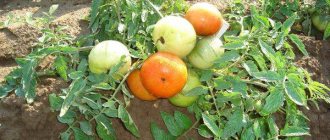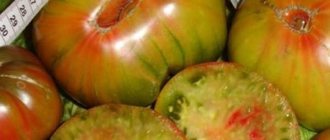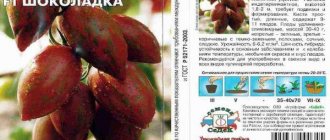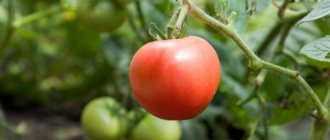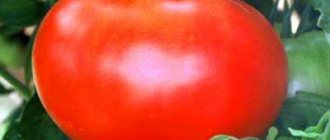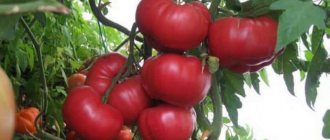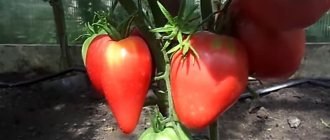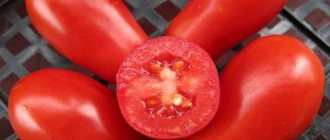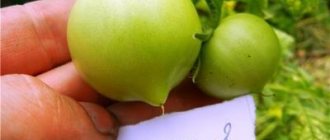Characteristics
Fruit characteristics
- After the fruits reach their varietal maturity, they acquire a bright red color.
- The weight of ripe tomatoes is approximately 180-240 grams.
- The pulp is fleshy, quite dense.
- The shape of the tomatoes is round, slightly flattened.
- The number of chambers in tomato fruits is from 4-7,
- dry matter content from 6 to 6.5%.
Unlike many other varieties, where the first fruits are larger than those that appear later, these fruits retain their weight and size throughout the entire fruiting season.
You can compare the weight of the fruits of this variety with others in the table below:
| Variety name | Fruit weight |
| Bobcat F1 | 180-240 grams |
| Premier | 120-180 grams |
| King of the market | 300 grams |
| Polbig | 100-130 grams |
| Stolypin | 90-120 grams |
| Black bunch | 50-70 grams |
| Sweet bunch | 15-20 grams |
| Kostroma | 85-145 grams |
| Brawler | 100-180 grams |
| F1 President | 250-300 |
First of all, this hybrid is very good for fresh consumption. You can also make homemade preserves from it. Thanks to the ideal combination of acids and sugars in its composition, these tomatoes make excellent juice and tomato paste.
Description of the variety
Tomato hybrid 6 Tarasenko
This hybrid variety was bred by breeders from Holland specifically for regions with warm climates. Tomatoes can easily tolerate hot weather, but in the northern regions, cultivation is possible only in greenhouse conditions.
Bobcat F1 bushes are of medium size, growing up to 1.1 m. They are quite wide and stocky in appearance, the branches are also well developed.
The species is determinate, which means active growth until the fruiting ovary grows. With its appearance, the growth of the bush practically stops. The first brushes may already appear after the 6th leaf, and after 3 leaves the ovary will begin to form. After 5-6 such ovaries grow, growth will stop completely.
Bobcat fruits grow quite large in size with a weight of up to 300 g. In shape, they are represented by a regular circle with a slight flatness, which is characteristic of a tomato. The soft skin has a glossy surface. Ripe tomatoes are painted deep red without any spots.
Productivity
The variety is interesting due to its good yield indicators. Thus, ripe fruits can be obtained already from 65 days after planting in open ground. Minimum quantity of tomatoes per 1 sq. m – 4 kg, average – 6-7 kg.
With proper care and optimal temperature conditions, it is possible from 1 sq. m to collect up to 8 kg of fruit.
Photo
You can see the tomatoes of the Bobcat F1 variety in the photo:
On our website you will find useful and informative articles about the secrets of growing early varieties of tomatoes in open ground. And also how to properly plant tomatoes and peppers in one greenhouse. And why do you need boric acid when growing these vegetables?
Characteristics of Bobcat tomato
Tomato amethyst jewel
Having fully studied the characteristics and description of the Bobcat f1 tomato variety, we can come to the conclusion that this crop can be grown by the laziest summer resident, because no special conditions are required for the vegetable to grow. Therefore, such tomatoes can be safely grown by those who do not like to mess around in the country.
Of course, this does not mean that the culture does not need care at all. Standard rules for selecting seeds, planting and fertilizing are important in growing absolutely any crop.
Bobcat tomato yield
According to reviews from summer residents, the yield of Bobcat f1 tomatoes is quite high. By creating the right conditions for growth, you can collect more than 8 kg of fruit from 1 m2, and this is one and a half times more than other hybrid varieties.
It is worth noting that this variety can be grown both in an open garden bed and in greenhouse conditions. When planted in greenhouses, the yield can increase significantly.
Area of application of fruits
Bobcat f1 tomatoes are used for preparing various dishes and winter canning. Tomato juice and tomato paste are made from fleshy tomatoes. Also, such fruits, unlike other varieties, are tasty fresh. With the right balance of acid and sugar, Bobcat tomatoes are a great choice for a summer salad.
Resistance to diseases and pests
Another advantage of the Bobcat f1 variety is its invulnerability to common infections. But preventative treatments should still be present. It is worth noting that such treatments are carried out using available means, without spending a lot of money.
Compliance with moisture regimes, loosening the soil and fertilizing will be an excellent prevention of many diseases. Don't forget about adequate cultural coverage. Perhaps this is one of the important conditions for successful cultivation.
Of course, you cannot do without pests that love to feast on this particular variety. Bobcat tomatoes are very fond of whitefly, which infects the green part of the bush. If the disease is not detected in time, it may affect future harvests.
According to reviews from summer residents, Confidor is a good insect repellent for the Bobcat f1 tomato. The plant is treated with this product by diluting 1 ml of the product in 10-12 liters of water. This mixture is enough to process more than 100 m2.
Important! With proper cultivation and care, Bobcat f1 tomatoes produce a bountiful harvest all season long.
Advantages and disadvantages of the variety
Growing Bobcat f1 tomato has many positive aspects.
Advantages of vegetable crops:
- high resistance to diseases and insect pests;
- ease of bush formation;
- Compact size bushes are easy to plant in any area;
- gives a good harvest, even if the tomatoes have been poorly cared for;
- tasty and fleshy fruits with a high sugar content;
- versatility in application;
- do not choke during transportation;
- can be stored for more than 30 days.
Perhaps one of the negative qualities of the Bobcat f1 variety is the late ripening period of the crop. If you plan to grow the crop in a cool area, then you should consider planting tomatoes in a greenhouse or even reconsider the choice of variety. In cold regions, it is better to give preference to early ripening hybrids.
Resistance to diseases and pests
Bobcat F1 tomatoes have good immunity, so the hybrid is resistant to diseases such as:
- fungal fusarium;
- tobacco mosaic;
- Alternaria blight;
- verticillium.
If the rules of agricultural technology, especially watering, are violated, there is a risk of powdery mildew.
According to the description of the Bobcat variety, it is not protected from pest attacks, so it is worth inspecting the plantings for the presence of:
- aphids;
- whiteflies;
- slugs;
- Colorado potato beetle;
- bear
If during the inspection insects or traces of pest activity are found, then the plants and nearby plantings must be treated with an insecticide. As a preventive measure, you should follow simple rules:
- Do not allow the garden to become overgrown with weeds.
- Do not place plants or beds close to each other.
- Maintain crop rotation.
Description of Bobcat tomato variety
Tomato raspberry flame
Hybrid Bobcat F1 belongs to the line of Dutch hybrids from SYNGENTA SEEDS BV. It was registered in 2007. This tomato is a late-ripening tomato (harvesting 120–130 days after emergence) and is recommended for cultivation in the North Caucasus region in open ground conditions. In the middle zone, Bobcats are also grown, but in greenhouses. But in the cold northern regions it will not be possible to obtain a harvest due to the late ripening of the hybrid.
Appearance
Bobcat is a determinate hybrid, that is, it has limited growth (up to 1–1.2 m). The bushes are covered with large dark green leaves. The inflorescences are simple. The first flower cluster appears after the 6th–7th leaf. The growth of the main stem stops after the formation of the ovary at the top of the bush. The fruit has a round, slightly flattened shape, with a ribbed or heavily ribbed surface. Tomato sizes range from 100 to 220 g, with an average of 180–200 g. Ripe tomatoes are bright red. The color is uniform, without a green spot near the stalk. The skin is durable, despite its small thickness, with a glossy sheen.
Bobcat fruit clusters bear 4–5 even fruits
The pulp is dense but juicy. Each tomato has 4–6 seed chambers. The fruit contains 3.4–4.1% sugars, which provides a sweet and sour taste. Tasters rate the taste of fresh tomatoes as good, and give tomato juice an excellent rating.
The fruits of the Bobcat hybrid reach a weight of 220–240 g
Positive and negative qualities of a hybrid
Vegetable growers usually praise the Bobcat tomato. Its advantages include:
- high yield (on average 4–6 kg/m2, under good conditions up to 8 kg/m2, which corresponds to a marketable yield of 224–412 c/ha);
- high yield of marketable fruits (from 75 to 96%);
- constant size of tomatoes in all harvest batches;
- heat and drought resistance;
- good transportability and keeping quality due to durable skin and dense pulp;
- resistance to verticillium and fusarium;
- Fruit resistance to heat treatment, which makes them ideal for whole-fruit canning.
Bobcat fruits are uniform, dense, with juicy pulp
The disadvantages of Bobcat include:
- limitation of cultivation area;
- the possibility of branches breaking off under the weight of the fruit, which makes tying necessary;
- requirement for care.
Table: comparison of late tomato varieties
| Index | Bobcat | Bull's heart | Titanium | De Barao |
| Ripening time | 120–130 days | 130–135 days | 118–135 days | 115–120 days |
| Plant height | Up to 1–1.2 m | Up to 1.5–1.7 m | 38–50 cm | Up to 4 m |
| Fruit weight | 100–220 g | 108–225 g | 77–141 g | 30–35 g |
| Productivity | 4–6 kg/m2 | 3–4 kg/m2 | 4–6 kg/m2 | 4–6 kg/m2 |
| Purpose | Universal | Salad | Universal | Universal |
| Growing possibilities | Open ground/greenhouse | Open ground/greenhouse | Open ground | Open ground/greenhouse |
| Disease resistance | High | Average | Weak | High |
Characteristics of the variety
The Bobcat F1 tomato was bred by Dutch breeders in 2000 and very quickly gained the attention of gardeners. Bush type: standard, determinate
The variety is recommended to be grown in open ground (only temporarily under film) and in greenhouses
The type of bush is standard, determinate. The variety is recommended to be grown in open ground (only temporarily under film) and in greenhouses.
Bushes and fruits
According to the description, the variety has powerful, stable bushes with a large number of large, bright green leaves.
The height of the bush is 70-80 cm, it needs staking and pinching. The type of inflorescences is simple. The fruits are round, slightly flattened, ribbed at the base, rich red in color.
Weight from 200 to 350 g. They have good density, glossy skin, and moderate thickness. The pulp has a slight sourness and is slightly grainy in structure.
Productivity
Tomatoes ripen in just 120-130 days from the moment the seeds are sown. The variety bears fruit abundantly, up to 3 months.
If you properly care for the bushes, apply fertilizing on time, do preventative maintenance and water, then you can harvest up to 10 kg of tomatoes per m², but if the Bobcat variety is grown in open ground, the yield will be less - 5-7 kg.
Resistance to diseases and pests
The variety is a hybrid, so the breeders took care of the resistance of immunity to diseases common to tomatoes (verticillium and fusarium) and pests, but prevention still won’t hurt, because stability is affected by climate, weather, sufficient moisture, and soil quality.
Area of application of fruits
Tomatoes can be used for household needs, as well as in industry. They are stored for a long time and are suitable for transportation.
When fresh, the fruits are very tasty, they do not spread and remain dense for a long time when cut into a salad. In hot dishes they retain their shape and original taste.
They are not very suitable for pickling and pickling for the winter due to their size (it is difficult to put them in a jar). It is better to use them for making tomato paste, sauces and juice.
Advantages and disadvantages
Among the advantages of the Bobcat F1 are the following:
- immunity to pests and diseases of nightshades;
- resistance to heat and drought;
- decent harvest;
- excellent taste of tomatoes;
- versatility of use;
- resistance to long-term transportation and cracking;
- good keeping quality;
- Suitable for growing for sale.
Among the disadvantages, it can be noted that tomatoes ripen late; not all regions can grow this variety. variety.
Features of cultivation
A step-by-step description of the technique for cultivating Bobcat tomatoes and photos will help gardeners properly organize care and grow a large harvest of these delicious tomatoes.
To obtain seedlings, tomato seeds are sown in March. Bobcat tomatoes are a hybrid, so only purchased seeds are used for sowing. They are already fully prepared for planting and do not require additional processing.
The seeds are placed at a depth of 1 cm, 2-3 cm from each other. The most convenient way to plant is to make grooves 1 cm deep in boxes filled with soil, then lay out the seeds and sprinkle soil on top. Then moisten the soil with water from a spray bottle, cover with film and place in a warm place.
After the mass emergence of seedlings, the film is removed. When 2-3 adult leaves appear, the plants are planted in cups and fed with potassium fertilizer
It is important to regularly water the plants and organize additional lighting to artificially extend daylight hours.
Before planting tomatoes in open ground, they are hardened off. To do this, they are taken outside every day, gradually increasing the hardening time from 1 hour to the whole day. Initially, the seedlings should be placed in the shade, then, when the plants become stronger, they can be placed in the sun. The age of seedlings at the time of transplantation into open ground or a greenhouse should be 50-60 days.
The soil in the tomato bed should be disinfected with a solution of copper sulfate (1 tbsp per 10 liters of water). You should not apply a lot of fertilizers; just add humus and wood ash.
The timing and characteristics of planting are determined by weather conditions and the place where the crop is grown. So, for tomatoes it is considered optimal to warm the soil to +15ºС. Bobcats in the middle zone are recommended to be grown in greenhouses; the approximate planting date is the first half of May. In the southern regions, where this variety is grown in open ground conditions, the end of May.
It is recommended to place plants on the site in a checkerboard pattern so that per 1 sq.m. there were 6-8 bushes. To do this, you should adhere to the 50x40 cm pattern.
If you follow these simple growing rules, Bobcat yields will be high:
- It is necessary to form a bush. For faster ripening of fruits and increasing their size, one stem should be left. You can leave two stems; the tomatoes will be smaller and ripen later, but more of them will grow.
- Tomatoes need garter.
- The bush should not be allowed to thicken: the plant should be pruned and excess leaves removed. You should remove leaves about 4 times a week so as not to cause unnecessary stress to the tomato.
- Bobcat should be watered twice a week, but generously. To prevent moisture from the soil from quickly evaporating, cover the ground with straw or hay.
- An important rule for caring for tomatoes in a greenhouse is frequent ventilation.
You can increase the yield of the variety by timely application of fertilizers. The first fertilizing is carried out 2 weeks after planting the seedlings, using nitrogen or nitrogen-phosphorus fertilizers. During the flowering period, fertilizing with potassium is carried out in combination with phosphorus and microelements. At the beginning of fruiting, it is recommended to add ash, superphosphate and potassium sulfate.
Most often, fully ripe fruits are collected, but it is also permissible to pick slightly unripe ones. Healthy tomatoes can be stored in a cool, dry place for at least a month.
Features of planting and growing
Since Bobcat is a hybrid variety, you will not be able to obtain planting material from it yourself - you will have to buy seeds. The hybrid must be grown in seedlings due to its late maturity. Sowing of seedlings usually begins in late February - early March. There is no need to treat the seeds before sowing - they are sold in packages already treated and ready to be immersed in the ground.
Landing algorithm:
- For sowing seeds, the best option is a ready-made soil mixture. If the soil is collected from the garden, then it must be calcined, pickled with potassium permanganate, and after drying, mixed with humus.
- The prepared mixture is poured into containers (you can use peat pots, plastic containers, boxes, plastic bags).
Peat pots can be used to grow seedlings
- The seeds are buried 1–1.5 cm into the soil.
- When sowing in boxes, the seeds are placed in lines every 2–3 cm (the distance between the lines should be the same).
If you sow in separate cups, it is advisable to put 2 seeds in each.
- The seeds are covered with a layer of soil and moistened (best with a sprayer).
- The containers are covered with film and placed in a room with a temperature of 23–25°C.
- When the tomatoes germinate en masse, the film must be removed and the seedlings placed in a cooler place (19–20°C).
Video: sowing tomatoes for seedlings
When 2 true leaves appear on the seedlings, the plants are planted in separate pots (unless they were immediately grown in separate containers); the optimal “age” of the seedlings is 10–15 days from the moment of germination. If you miss this deadline, the roots of neighboring plants will become very intertwined and will be seriously damaged when picking. You should not pinch the central root - it usually loses its tip during transplantation.
Untimely or careless picking can cause a delay in the development of tomatoes for 7–8 days, which subsequently results in a lost harvest, especially for late-ripening Bobcat.
The volume of picking pots should be 0.8–1 liters. If you use smaller containers, you will have to replant again in the future.
After picking, the seedlings are fed with superphosphate and potassium sulfate (a pinch for each plant), to which you can add a little vermicompost. Then fertilizing is repeated every 2–3 weeks. Otherwise, caring for seedlings consists of timely watering and long-term lighting. As a rule, in early spring, natural lighting is not enough for tomatoes (it requires 10–12 hours a day), so it is necessary to organize additional lighting using fluorescent or LED lamps.
Planting a Bobcat tomato in a permanent place
Transplanting seedlings to a permanent place (in open ground or a greenhouse) is carried out only in established warm weather - tomatoes do not tolerate return frosts. Before planting (12–15 days before), the seedlings need to be hardened off by exposing them to the open air. This is done during the day, choosing a place in the shade, first for 1 hour, then increasing the stay time to the whole day.
Before planting in a permanent place, the seedlings are hardened off
The soil for Bobcat should not be overly nutritious; it should not be enriched with organic matter - it causes the tomato to fatten. It is important to disinfect the soil before planting. To do this, use a solution of copper sulfate (1 tbsp per bucket of water).
Bobcats are usually planted in holes or furrows in a checkerboard pattern. There should be an interval of at least 50 cm between neighboring bushes, and at least 40 cm between rows, that is, about 4–6 plants per 1 m2.
Tomato care
Caring for this hybrid is practically no different from the technology for growing other determinate tomatoes. To obtain maximum yield, you should adhere to the following rules:
- to prevent shoots from breaking off under the weight of the harvest, it is necessary to tie them to a trellis;
- timely removal of excess stepsons contributes to better formation of ovaries;
- to reduce foliage, remove 3–4 leaves every week;
- When cultivated in a greenhouse, Bobcat requires frequent ventilation.
The hybrid prefers abundant watering, but not more than 1–2 times a week. Although the fruits are not prone to cracking, you should not allow excess water in the soil.
To maintain optimal soil moisture, it must be covered with a layer of straw or hay.
Although the hybrid can develop without fertilizing, during ovation and active fruiting it is still advisable to enrich the soil with the necessary nutrients. Tomato requires:
- potassium,
- boron,
- iodine,
- manganese.
You can use ready-made complex fertilizer or prepare the mixture yourself. Ash (1.5 l) mixed with boric acid powder (10 g) and iodine (10 ml) gives a good effect. The fertilizer is dissolved in 10 liters of water and the plantings are watered.
There is no need to feed tomatoes with nitrogen and organic matter! These fertilizers only cause green growth.
Bush formation
For the Bobcat hybrid, bush formation is very important. The fact is that plants form many stepsons and foliage, which reduces the formation of ovaries. Bushes can be formed into one or two stems.
Unlike early varieties, the formation of three stems is not suitable for Bobcat - the ripening of the fruit will be greatly delayed.
When growing a plant into one stem, all the stepsons are removed, leaving only the central stem, and when forming into two stems, one side shoot is left in the axil of the third leaf
The choice of shaping method depends on the desired result. If only one stem is left, the fruit will ripen about a week earlier, and the tomatoes will be large. However, the total number of fruits will not be too large. When growing a plant with two stems, the yield will increase noticeably, but ripening will be delayed, and the size of the tomatoes will be small.
Video: formation of Bobcat tomato
The author's experience in growing tomatoes shows that the main point of caring for plantings is the organization of watering. Moreover, contrary to popular belief, tomatoes respond very well to sprinkler irrigation. You can even use cold water, straight from the well. It is convenient to use a sprinkler as a sprinkler. Tomatoes do well under a canopy, for example, from grapes. It protects from excessively hot sun, plants get sick less and their leaves never curl.
Recent Entries
5 working ways to use tar in the garden 7 indoor plants that help you get married even in adulthood Indoor plants that can bloom in trouble
Protection from pests and diseases
The originators claim that the hybrid is resistant to diseases such as tobacco mosaic, fusarium and verticillium. With the correct watering regime and good lighting, plants successfully resist powdery mildew. Good disease prevention is proper soil care (timely loosening, hilling, weeding) and fertilizing.
In case of strong moisture, it is recommended to treat the bushes with Quadris or Ridomil Gold to prevent late blight.
Of the pests, the Bobcat can be afraid of whiteflies and aphids.
The whitefly settles on the lower surface of leaves and lays eggs. The larvae stick to the leaf and suck out the juice, and their secretions are a breeding ground for sooty fungus. The whitefly feels especially good in poorly ventilated greenhouses.
Whiteflies are located on leaves in entire colonies
You can get rid of whiteflies using fly stickers, which are hung in the rows. You can also light an incandescent light bulb over the bed at night, on which insects attracted by the light burn their wings. If folk remedies do not help, you need to treat the plantings with Confidor (1 ml per bucket of water).
Aphids can move to tomatoes from other plants, so the bushes need to be inspected regularly. If you miss the onset of an insect invasion, the tomatoes may even die - aphids very actively suck the juices from the leaves.
Aphids cling to the lower part of the leaves and suck out the juices
The following drugs are suitable for chemical treatment against aphids:
- Biotlin,
- Akarin,
- Spark.
After treatment, tomatoes cannot be eaten for 20–30 days, so before spraying you need to remove all tomatoes that are starting to turn pink and put them to ripen.
Harvest and use
The first harvest of Bobcat tomatoes can be harvested 4 months after seed germination. The fruits ripen in batches and, accordingly, have to be collected in several stages. If you wait until all the tomatoes ripen, the shoots may not withstand the weight.
Thanks to their dense pulp and durable skin, tomatoes can easily be transported and are stored well (up to 1.5–2 months at a temperature of 1–3°C). Bobcat is intended mainly for preparing various preparations - tomato paste, ketchup, sauces, as well as for canning whole fruits. However, the good taste of the fruit allows them to be used for salads.
Bobcat produces high quality tomato paste
Tomato Bobcat characteristics and description of the variety
Bobcat is a hybrid variety that was bred specifically for regions with high humidity and high temperatures. It comes from Holland, but it is grown in any region, but at low temperatures it is better not to plant it in open ground, but to give preference to greenhouses.
The peculiarity of the variety is large, juicy, but at the same time fleshy fruits. They are quite large and 1 tomato can reach 250–300 g. The color of a tomato can range from soft pink to bright red. The shape of the fruit is round, slightly flattened on top.
The bobcat is not picky and requires minimal effort when growing, so it is suitable not only for the garden and home garden, but also for planting on an industrial scale. The fruits tolerate transportation well, can be stored for a long time and are resistant to changes in temperature.
Bush
The Bobcat tomato bush is much larger than other varieties, and its height ranges from 1 to 1.5 meters. As a rule, the bush is formed into 1 or 2 stems, the remaining shoots are cut off with pruning shears during the maintenance process. The fewer stems, the larger the fruits.
Another feature of the plant is its shallow root system, due to which growth goes into stems and fruits. It is necessary to plant the crop in time so as not to miss the opportunity to get large fruits.
Fruits and yield
The Bobcat F1 variety is characterized by high productivity and bears fruit, subject to proper care, from mid-summer to autumn. The average yield is up to 8 kg per 1 sq. m, which is several times higher than the yield of other tomato varieties.
The fruiting rate of this variety varies and depends on many factors: climate, soil type, frequency of watering and fertilizing. On average, the first harvest is harvested 70 days after planting in the ground, although in some cases this period can last up to 100 days, but this will not affect the taste and quantity of the fruit.
When growing tomatoes in greenhouse conditions, the yield level can increase by 1.5 times.
Immunity to diseases and parasites
Unlike other tomato varieties, Bobcat boasts high resistance to parasites and diseases. This plant has high protective functions and strong immunity, due to which it is less susceptible to the negative effects of pathogens. Despite this, it is still recommended to take preventive measures and introduce antibacterial fertilizers.
Some parasites infect plants, so it is necessary to carry out prevention several times a season:
- When planting seeds and seedlings, they need to be treated with a light solution of manganese, which disinfects and prevents future infection.
- Before flowering, it is recommended to treat the bushes with drugs or folk remedies (for example, copper sulfate, garlic juice or ash) against whiteflies and caterpillars. They affect the tops and foliage, which will negatively affect the amount of harvest.
Experienced gardeners advise using the universal preparation “Confidor”, which protects tomatoes from diseases and pests.
Tomato Bobcat: planting, growing and care
The crop is grown in seedlings. Bobcat tomato seeds should be purchased in specialized departments and stores.
When planting Bobcat tomato seedlings, you should know a few nuances:
- the need to prepare soil for seeds. Some vegetable growers purchase ready-made mixtures in stores. Those who use soil from their summer cottage must carry out the procedure for disinfecting the soil, after which they warm it up and combine it with humus;
- boxes for planting seeds should be spacious enough. Bobcat tomato seeds are buried 1.5 cm deep, maintaining a distance of 3 cm between the seeds;
- after planting, the seeds are lightly sprinkled with soil and the soil is moistened;
- boxes with Bobcat tomato hybrid seeds are covered with film, creating a greenhouse effect, and put in a warm place until the seeds germinate;
- when the seeds “hatch”, the film is removed, placing the boxes with seedlings in a well-lit place. Most often, this is a window sill;
- After 2-3 days, the sprouted seeds sprout. At this stage, it is important to provide the seedlings with sufficient light and moderate watering. If there is a lack of natural light, install artificial lamps;
- By the end of spring, as a rule, the seedlings reach the required size for planting in a permanent place of growth. Before this, experienced gardeners advise hardening off the seedlings so that they can quickly adapt to new conditions and grow into a healthy, strong bush.
- Hardening begins by taking the seedlings out into the open, leaving them for 1-2 hours, the time is gradually increased to 24.
Only after this they are planted in a permanent place of growth. In general, it takes about 2 months to form adult seedlings.
Planting Bobcat tomatoes in open ground
Before planting Bobcat tomato seedlings in open ground, prepare the holes in advance, placing them in a checkerboard pattern, maintaining a distance of half a meter or more between plants. This is necessary for the full development of each bush.
Before planting, the soil is disinfected with a solution of copper sulfate (a tablespoon per bucket of water). To fertilize the soil, add tree ash or humus.
Bobcat tomatoes photo
Bobcat F1 tomato care
As already mentioned, there are no problems with the formation of a bush. Usually the Bobcat variety is formed into one stem. If you leave a couple of stems, the fruits will be smaller than in the first case, this is worth keeping in mind.
The best varieties of tomatoes - descriptions and reviews!
• Tomato MYSTERY • Yellow original tomatoes BANANA LEGS • Large variety HEAVYWEIGHTER of Siberia • Early ripening tomatoes RED GUARD
To obtain an excellent harvest, you must follow the rules:
- be sure to tie the bushes to supports, otherwise the branches may break under the weight of the growing fruits;
- promptly remove unnecessary leaves and branches;
- Watering should be moderate and timely. It is enough to water 2 times every 7 days;
- to retain moisture in the soil for a longer time, mulch with straw;
- when Bobcat tomatoes develop in greenhouse conditions, it is necessary to systematically ventilate the greenhouse;
- application of fertilizing (mineral, organic) up to 3 times per season.
Care
Despite the average size of the bush, the plant is extremely demanding of fertilizer and watering. This explains its high productivity. You should also not forget about removing weeds, loosening and removing excess leaves.
Top dressing
On average, fertilizing is carried out every 2-3 weeks. The first two are based on growth stimulation, therefore they consist of urea (the working solution is prepared in accordance with the instructions). They are carried out when growing seedlings. After transplanting into the ground, fertilize in accordance with the following scheme:
- on the 14th day, 1 liter of solution is added to each plant, obtained from 1 kg of humus and 1 liter of water, infused for a week (before use, 1 liter of fermented organic matter is added to 10 liters of water);
- the flowering plant is fed with Kemira Lux (1 tbsp per bucket of water);
- at the moment of formation of the ovaries, repeat the fertilizer with Kemira Lux.
Stepsoning
The bush is susceptible to the growth of stepsons. If you leave 1 trunk, the plant will be more powerful, but many grow 2-3 to increase the volume of the harvest. To increase air access, remove excess leaves.
Watering
Tomatoes respond well to abundant regular watering. However, the soil should not be over-moistened. It is optimal to carry out the procedure 2 times a week.
Growing seedlings
Before planting tomatoes in the ground, seedlings are grown. This is usually done at home on the windowsill.
Planting material is sown in early or mid-March (times are calculated depending on the region).
Preparing the seeds
Before you start growing seedlings, prepare your planting material. Make sure the seeds have not expired. An expired product will have low germination.
Seed preparation:
- Sort out the planting material. Remove damaged and blackened seeds.
- Bobcat does not require preliminary disinfection. Therefore, there is no need to treat the seeds with potassium permanganate. To check the germination of seeds, you can soak them in a weak salt solution. The floating material will not rise, so it is removed.
- Before planting, the seeds can be soaked in a growth stimulator. To do this, you need to cut the gauze and moisten it with liquid. The seeds are placed in it for 12 hours.
Selecting container and soil
For sowing seeds, it is better to take a large container. This will make it possible to fit all the planting material in one container. At the same time, the pot may not have much depth.
After germination, the plants are planted in individual pots. To do this, you can use ordinary half-liter plastic cups or peat pots.
You need to prepare glass or film with which you will cover the sprouted seeds for the first time.
The container is disinfected before use. This will reduce the likelihood of plant infection.
Soil for planting can be purchased at a specialty store. Such soil contains all the necessary microelements.
Homemade soil is also suitable for growing seedlings, but you shouldn’t just take soil from the garden. To provide the plants with the most comfortable conditions, a mixture of turf, humus, peat (1:1:1) is prepared and a glass of ash is added for every 10 kg of the mixture.
Before use, the soil must be disinfected. One of the options for soil disinfection is treatment with a weak solution of potassium permanganate. Calcination at a temperature of 80 degrees can also be used for these purposes.
Sow the seeds
The seeds are planted in a prepared large container. To do this, grooves 1 cm deep are made in pre-moistened soil at a distance of 2 cm from each other. Seeds are placed in the recesses at a distance of 1 cm.
The planting material is sprinkled with a small amount of soil on top. The earth cannot be compacted.
The container with seeds is covered with glass or film and placed on a windowsill or under a phytolamp.
The optimal temperature for seed germination is 25 degrees. To ensure an optimal level of humidity, the film covering the seeds must be opened slightly every day for several hours.
Rules for caring for seedlings
Compliance with all the rules is a guarantee that you will grow strong and viable plants.
Rules for caring for seedlings:
- Seeds planted in a common container are moistened as the soil dries. This should be done from a spray bottle with water at room temperature.
- Two weeks after sowing the seeds, you can remove the film from the container in which they were grown.
- When true leaves form on the plants, they are transplanted into separate containers. If the root of the plant is too long, then the lower fragile part can be pinched off. This will allow the plant to take root better.
- After pinching down one-third of the plant roots, their growth may temporarily slow down. There is no need to be afraid of this, since in the future the indicators will normalize, and the plant will be more resilient and strong.
- Tomatoes placed in individual containers are watered with water from a watering can. This must be done carefully so as not to wet the greens.
- A week after picking the seedlings into separate pots, they are fed with compositions based on vermicompost.
- Two weeks before planting tomatoes in the ground, you need to start hardening them. Pots with Bobcat are taken out onto the balcony or street during the warm time of the day. You need to start with 15 minutes, gradually increasing the time to the whole day.
How to plant Bobcat tomatoes in an open area and in a greenhouse
You can plant tomatoes in the ground using seeds or seedlings, which you can buy or grow yourself. When planting in an open area, you need to choose an area that has more sun and less shade, because this variety loves heat. When planting in a greenhouse, the presence of sun does not matter. Since the Bobcat needs a lot of light, artificial greenhouse lighting can be provided.
Seeds
When sowing seeds, you can expect germination within 9–11 days. If it's warm outside, maybe earlier. Experienced gardeners recommend growing seedlings separately and then planting them in the ground. The exact sowing date is different for all regions, but it is worth starting from the expected date of planting in the ground. You need to subtract 60 days from it. Typically, seeds are sown from February 20 to the end of March.
Before planting, the seeds do not require special preparation: they do not need to be heated or disinfected. In some cases, you can soak it in a solution of potassium permanganate for a day.
First, you need to prepare containers for the seeds - plastic cups, pots or cut-off eggplants, plastic boxes. They are filled with soil that needs to be moistened. At intervals of 3 cm, you need to make holes in the soil into which the seeds will sit. Place 1 seed in each hole so that you don’t have to plant bushes later. Next, they are covered with soil and covered with a film, which will need to be removed a few days after germination. Polyethylene will provide a sauna effect, due to which the seedlings will sprout faster.
Seedlings
Seedlings should be planted in open ground when they reach a height of 10–12 cm. They are carefully uprooted from the container along with the soil and placed in a plastic bag or cloth soaked in a manganese solution.
In a greenhouse or garden, you need to dig up and fertilize the soil. Before planting the seedlings, water them. It is better to plant tomatoes in the evening or early in the morning, but not during the day when the sun is too active. It is impossible to say exactly by dates, but on average Bobcat lands in the last ten days of May.
See also Tomato variety Diabolik f1: yield and growing characteristics
Holes up to 10 cm deep are made at a distance of 40–50 cm of arcs from each other. Superphosphates, organic compost or humus can be used as fertilizer. After planting, water a little. The height of the bush can reach up to 1 m, so it is recommended to leave space between the rows for twigs for garter.
Replanting is stressful for a plant, so in the first week you need to provide it with normal lighting, temperature and watering.
Tomato Bobcat F1: variety description
| Variety name | Bobcat |
| Originator | Syngenta, Holland |
| Ripening period | 120-130 days |
| Form | the fruits are flat-round, slightly ribbed at the stalk, dense and glossy |
| Color | red at maturity |
| Average weight of tomatoes | 180-240 grams |
| Height | 50-70 cm |
| Application | universal, well-defined tomato taste with noticeable sourness, used both fresh and for processing into tomato products |
| Productivity of the variety | 4-6 per sq.m. |
| Features of cultivation | Sowing 60-65 days before planting, planting pattern 50x40 cm, 6-8 plants per 1 sq.m, picking at the stage of 2 true leaves |
| Disease resistance | Resistant to verticillium and fusarium |
Progress does not stand still, and the agricultural industry is no exception. “Bobcat” can without any doubt be called a revolutionary hybrid variety. This hybrid was obtained by breeders from Holland. It received registration in Russia in 2008, and has since earned recognition from both gardeners and farmers who grow tomatoes in large quantities for sale.
This is a medium-sized plant, approximately 50-70 centimeters. The Bobcat tomato belongs to the group of hybrid tomato varieties. It is intended for cultivation both in open ground and in greenhouses. The type of bush is determinant, standard. The height of the Bobcat tomato bush can sometimes reach 1.2 m.
From the moment the seedlings are planted until the first fruits of varietal maturity appear, approximately 120-130 days pass, that is, the plant is late-ripening. The hybrid is resistant to all major tomato diseases.
In addition to a number of remarkable properties, this varietal hybrid has quite good yield. With proper care and creation of suitable conditions from 1 sq. per meter it was possible to get 8 kilograms of wonderful tomatoes, but this is rather an exception, the average yield is 4-6 kilograms.
You can compare the yield of the Bobcat variety with other varieties in the table below:
| Variety name | Productivity |
| Bobcat F1 | 4-6 kg per square meter |
| Russian size | 7-8 kg per square meter |
| King of Kings | 5 kg per bush |
| Long Keeper | 4-6 kg per bush |
| Grandma's gift | up to 6 kg per square meter |
| Podsinsky miracle | 5-6 kg per square meter |
| Brown sugar | 6-7 kg per square meter |
| American ribbed | 5.5 kg per bush |
| Rocket | 6.5 kg per square meter |
| De Barao the giant | 20-22 kg per bush |
Characteristics of tomato
Before planting a vegetable and growing tomato bushes, you will have to familiarize yourself with the characteristics of the tomato.
Bobcat tomato yield
The main characteristic that interests many gardeners is the yield of tomatoes. Bobcat is a variety with an average harvest period, which manages to ripen within two months. From a square meter of garden, 3-5 kilograms of ripe fruits are collected. Some vegetable growers who plant vegetables in greenhouses manage to increase yields by up to eight kilograms.
Growing regions
This is a heat-loving plant, and therefore experienced gardeners advise planting it in the southern regions for better yield. Only in such regions can vegetables be grown in open ground. Gardeners living in the northern regions must grow tomatoes in greenhouses, where the temperature will always be above zero.
Resistance to diseases and pests
The Dutch variety of tomatoes is known for its strong immunity, which copes with many diseases and pests. The bobcat is reliably protected from the following common pathologies:
- verticillium;
- tobacco mosaic;
- Fusarium fungus.
The plant sometimes suffers from a disease such as powdery mildew. However, if you grow tomato bushes at the optimal temperature and care for them properly, the disease will not appear.
Bobcat tomatoes - description
If you read reviews about this crop, then often when gardeners write about the positive aspects, they begin with a description of the tomatoes themselves and the fruits. And this is the right decision, since any person planting a variety on the territory wants to get a tasty and high-quality harvest.
- When fully ripe, the fruit becomes a rich red color, glowing a little orange in the sun. Also, there should be no green spot near the stem of the fruit.
- The shape of the fruit is slightly elongated, the shell is dense, but thin. Therefore, it is not felt when eating, and is also slightly ridged.
- The pulp is quite fleshy, with excellent taste and aroma. When the fruit is cut open, you can see 5 chambers in which the seeds are located.
- With proper care, the harvest stabilizes and becomes regular from year to year.
Note: Since the shell of the fruit is dense, they are perfectly preserved as a whole, without bursting, like many varieties. It doesn’t even shrivel, as the skin makes it a heat-resistant variety.
Bobcat tomato
Storage
Fruits that have already been collected are perfectly stored for about 20-30 days. The Bobcat tomato tolerates transportation well, so it can be transported even over long distances.
Tomatoes are often used both for preservation and processing. Tomato paste or juice is prepared from them. Due to the correct content of sugars and acids, the fruit is very tasty when fresh, which is why it is used in salads.
Pros and cons of the variety
To decide whether to plant this variety, you need to study all the positive and negative qualities.
Pros:
- The variety is resistant to short-term droughts and excess moisture in the soil. But it is recommended not to tempt fate and avoid droughts and waterlogging.
- High resistance to many diseases and viruses.
- Excellent taste and aroma of tomatoes.
- Even with a little care, the plant will still produce a good harvest.
- The fruits can be used in different areas, that is, they are universal in use.
Minuses:
- Refers to late ripening varieties.
- When grown in northern regions, the variety cannot develop in open ground. Therefore, it is planted only in closed ground.
Bobcat tomatoes on video
You can see other interesting varieties and hybrids of tomatoes with photos, descriptions and reviews in our Tomato Catalog. Enjoy watching.
If you have grown Bobcat tomatoes, please write whether you liked them or not. What was the taste of the fruit and yield under your climatic conditions? How do you assess the disease resistance of this hybrid? Briefly describe what, in your opinion, are the advantages and disadvantages (pros and cons) of this tomato. If possible, attach a photo of the entire bush or individual fruits you grew to your comment. Thank you!
Your reviews of the Bobcat tomato and additions to the description will help many gardeners evaluate this hybrid more objectively and decide whether it is worth planting or not.
Main rules of cultivation
The description of the variety makes it clear that tomato seeds should be planted in March or early April. No special preparation is required; for planting you will need ordinary soil with the addition of humus. The seeds are laid out on the ground, then they are sprinkled. Using a sprayer, the soil with plantings is wetted. The container with seeds is covered with film or glass.
Experts are confident that the Bobcat f1 variety can be considered a revolutionary tomato
After the seedlings are obtained, the box with seedlings is exposed to light and the film is removed. When two true leaves appear on the plants, you can pick (transplant) the crop. During the period of seedling growth, it is fertilized with potassium fertilizers. In order for the sprouts to be strong and strong, it is worth organizing the lighting with LED or fluorescent lamps. On warm days, it is useful to harden boxes with seedlings in a greenhouse or outside; to do this, it is enough to keep the plants in sunlight - for adaptation, but for a short time.
Almost all varieties of tomatoes require shaping, Bobcat is no exception. If you want to get an early harvest, you should form the plant into one trunk. To get a larger harvest, you will need 2 stems, but the ripening time for vegetables will be delayed.
Almost all tomato varieties require shaping, Bobcat is no exception.
It will not be possible to grow an enviable number of tomatoes if the extra stepsons that take away the strength of the plant are not removed. In addition, it is better to tie the bushes to supports; watering is carried out 1-2 times a week, but this depends on weather conditions. When cultivating a variety in greenhouse conditions, do not forget about ventilating the room.
Growing tomatoes
To calculate the planting time, you need to estimate the date of planting in open soil and subtract 65 days. However, these deadlines will differ in different areas.
- In the south of the country, the time to start seedlings is from late February to mid-March;
- In the middle zone - from mid-March to early April;
- In the north - no earlier than April 1.
How to prepare seeds?
Hybrid Bobcat F1 is immune to many diseases, so pre-treatment of seeds (warming, soaking, heating in the oven) is not required. The seeds from the bag are already ready for sowing.
Sowing seed material
The landing must be carried out according to the following rules.
- Seeds are planted at a distance of 1.5 cm in moistened, clean soil to a depth of 1 cm;
- The holes filled with soil are moistened, covered with film and placed in a warm place;
- If the soil dries out, it is periodically moistened with a sprayer;
- Very wet soil is left temporarily uncovered;
- After 1.5-2 weeks, the film is removed.
IMPORTANT: In order to harden the plant, the container with the first shoots is taken out into the fresh air (balcony, terrace or even street) for several hours. The optimal air temperature is +15 +20 degrees.
Rules for planting seedlings
The time of transplanting seedlings into separate containers is determined by the appearance of 2 true leaves. But first you need to prepare the ground. It is disinfected with copper sulfate and enriched with fertilizers (ash, humus). But adding fresh manure to the soil is strictly prohibited.
Planting of seedlings is done in a checkerboard pattern, with 4-5 plants per 1 sq.m.
How to care for bushes?
Further care of the bushes is as follows:
- Tying the bush to a support installed 10 cm from it. This will help the stem cope with the weight of the fruit;
- Removing 4 leaves per week improves yield;
- The number of abundant waterings should not exceed 2 times a week;
- Retention of moisture in the ground is ensured by a mound of straw or dry grass under the bush (mulching);
- It is necessary to get rid of stepchildren in a timely manner, as they prevent the bush from absorbing nutrients;
- Forming a bush with 2 trunks will provide a larger, albeit later, harvest compared to bushes with 1 trunk;
- Feeding bushes leads to a significant increase in tomato yield;
- When growing the Bobcat F1 variety in a greenhouse, frequent ventilation is necessary.
Disease and pest control
The hybrid is distinguished by its high resistance to most diseases (verticellosis, rot, blight, fusarium, tobacco mosaic) and typical pests. However, you should not avoid preventive measures.
- Sufficient light and proper watering will prevent the appearance of powdery mildew;
- Regular inspection of the stems will help you notice in time the appearance of aphids that have spread from neighboring bushes;
- When bushes are damaged by pests, insecticides can be used.
REFERENCE: Confidor will help you fight whitefly (the most common pest of tomatoes). Working solution – 1 ml per 10 liters of water.
Disease and pest control
For common diseases, the Bobcat is considered an invulnerable hybrid. However, prevention should not be neglected, especially since it will cost no special labor or financial investments. What a tomato needs is compliance with the watering and fertilizing regime, loosening the soil, and also providing the seedlings with high-quality lighting.
Insects are pests of tomatoes. The whitefly can cause harm to the Bobcat. The inexpensive drug Confidor is suitable for the fight. It is diluted in a proportion of 1 ml per 10 liters of water. This amount of solution is enough to treat tomato plantings of 100 m2.
